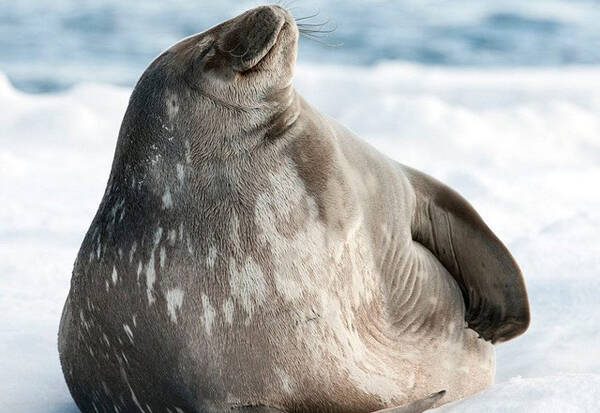Leptonychotes weddellii
IUCN
LCBasic Information
Scientific classification
- name:Leptonychotes weddellii
- Scientific Name:Leptonychotes weddellii,monk seal, Weddell seal, Weddell seal, Weddell seal
- Outline:Carnivora
- Family:Phocaea W.seal
Vital signs
- length:About 3 meters
- Weight:About 300kg
- lifetime:8-10years
Feature
It was the first seal Columbus saw in the "New World".
Distribution and Habitat
Mainly distributed in the waters around Antarctica and near the coast of Antarctica
Appearance
Weddell seals are about 3 meters long and weigh more than 300 kilograms. Females are slightly larger than males. They have a black back and light gray other parts, with white spots on the sides.
Details
Weddell seal (Latin name: Leptonychotes weddellii), also known as Weddell seal, Weddell seal or Weddell seal, is the only species of Weddell seal genus under the seal family, named by a British Antarctic navigator James Weddell.

Weddell seals are an extremely ancient creature, so they are called "living fossils". They were once recorded in Aristotle's books and were also the first seals Columbus saw in the "New World". Weddell seals were once found throughout the Pacific Ocean, the Caribbean Sea and the Mediterranean Sea. Today, there are only about 750,000 in the world.
Weddell seals are the winners of long and deep dives, feeding on fish, cephalopods and other marine creatures. For example: squid and krill. When hunting, they can dive to a depth of 500 meters, maintaining the time for 20 to 73 minutes, but usually within 25 minutes. Because they have to return to the blowhole to breathe, their "combat radius" when diving and hunting is not too far, and the farthest record is 12 kilometers.
Weddell seals need to constantly surface to breathe, each interval is 10 to 20 minutes, and the longest can be up to 70 minutes. When there is no ice, it is easy to float to the surface to breathe. However, when the sea surface is frozen, breathing becomes a big problem for Weddell seals. When a Weddell seal is trapped in the bottom of sea ice or floating ice, it cannot surface to breathe at any time. When it is too stuffy to bear, it will gnaw the ice desperately. It took all its life's efforts to gnaw a hole, so that it can get out of the hole, lie weakly, and breathe the air to its heart's content. However, its mouth was worn out, and blood flowed, dyeing the inside and outside of the ice hole red; its teeth were shortened, flattened, and worn away, and it could no longer eat, nor could it fight with its powerful enemies. It is for this reason that Weddell seals, which could have lived for more than 20 years, generally only live 8 to 10 years, and some even die after only 4 to 5 years. What's more serious is that some Weddell seals died of lack of oxygen and exhaustion before they got out of the hole. In order to preserve the ice hole that they exchanged for their blood and life, Weddell seals have to gnaw again every once in a while to prevent the hole from being frozen again. In this way, the ice hole becomes its portal to enter and exit the ocean, breathe and carry out activities.

Weddell seals are solitary animals, but females gather in groups of up to 100 during the breeding season. When female seals are feeding on the ice, male seals will stay on the seabed under the ice to guard the territorial waters and blowholes, monopolizing the female seals above in disguise. Compared with ordinary seals, Weddell seals are more docile and their teeth are not as sharp as other seals that eat crabs, which makes them more popular with whales that prey on them.
Weddell seals breed on the ice, giving birth to one pup per litter. The milk has a high fat content, and the pup appears particularly fat and cute. Weddell seals are found in sea ice areas and can survive the long, dark winter under the sea ice.
The Weddell seal brain consumes very little oxygen, which is very beneficial for diving. The blood of a Weddell seal contains 1000 milligram molecules of oxygen. The brain only uses 3-4% of the blood oxygen in 70 minutes, while the human brain uses 90% of the blood oxygen in the same time. The heart of a Weddell seal uses 14% of the oxygen in 70 minutes, while the human heart uses 57%. Judging from the oxygen consumption of the brain and heart of a Weddell seal alone, it has the potential to extend its diving time. In contrast to humans, the head of a Weddell seal is pitifully small, only about 5% of the human brain. It is not unreasonable for such a huge creature to have a small head that is less than 1/1000 of its body weight. This may be one of the secrets of the Weddell seal's ability to dive deep and long.
Protect wildlife and eliminate game.
Maintaining ecological balance is everyone's responsibility!








